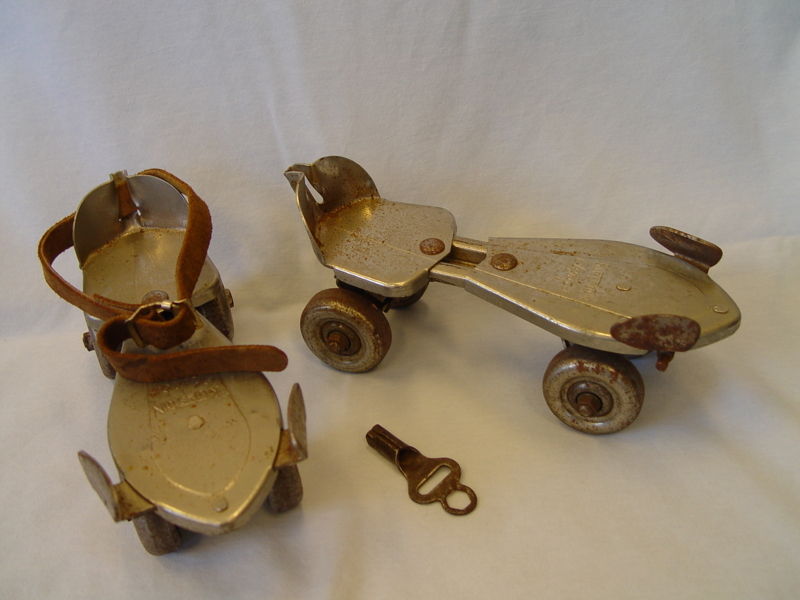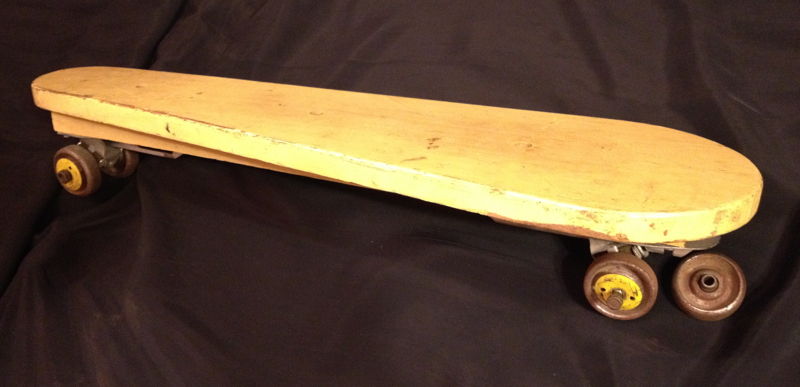
The following article by David Strange originally appeared in The Courier-Journal on 30 May 2012. It is archived here with additional information for your reading enjoyment.
In the Bullitt County History Museum, sitting among a small display of antique toys, sits a pair of metal roller skates.
Most people now look at them and wonder what they are.
But people of a certain age look at them and smile, memories of happy summer days dancing in their eyes.

When I was a boy in the 1950's and '60's, tennis shoes were not yet in style for everyday wear. Most everyone wore stiff, leather-soled shoes like "saddle oxfords" or just plain black leather shoes.
And this was a good thing for skating. A kid could just bring along his metal skates, pull a skate key from his pocket when needed, clamp those skates right on his shoes, and he was good to go. Later on, when tennis shoes became popular, the soft rubber soles of those shoes would not allow for skates to clamp on them, and so metal skates soon went the way of bobby-soxers and poodle skirts.
Metal skates might look archaic today, but they were great fun "back then."
The biggest challenge was finding a place on which you could use them.
Many driveways, and even roads, were gravel back then. A perfect example of disappointment could be found in the face of a happy child, with his brand new metal skates, hopping out on the driveway expecting to roll along effortlessly, but instead hitting the gravel and going maybe an inch before the wheels dug in and came to a dead stop. Trying to roller skate on gravel usually looked more like walking on Japanese platform shoes than actually skating.
Metal skates on concrete driveways, not to mention wood floors, could be trouble too. You see, those metal skates rolled really well on such surfaces, but the metal wheels could also make some pretty permanent scratches. I remember a neighbor being pretty upset when he got a nice new concrete driveway, and we neighborhood kids innocently scratched it up almost right away with our skates.
So paved, low-traffic roads were often the place of choice for us metal skaters.
One skating memory of mine involves a very kind neighbor. I'm sorry to say that I have long since forgotten his name. This man had a wood shop in his garage, and if a kid would bring him one metal roller skate, he would separate that skate into two parts, and add a beautiful wood top to the skate, making a pretty darn good skateboard for the time.
And he did it for free.

Looking back at it now, we boys probably barely thought to thank him, but I'm sure he saw the happiness in our eyes. That kind neighbor reminds me of one of my favorite sayings, "Your works shall live on." Long after your name is forgotten, the good or bad that you do will live on in others.
Today, because of the fears and realities of modern day perversions, I suppose a man doing that might be looked on with suspicion or even fear. I know that even in my neighborhood, as I try to return the favor to the next generation, I can see kids and parents sometimes wonder what this strange guy is up to when I offer them ice cream or offer to fix their bike. Suspicion, and the need for it, is the gravel driveway of our times.
But back to the skateboard.
My older brother, Dale, about killed himself on that skateboard one time. One day, several of us kids found a great, long, steep, paved road that looked like a fine daredevil ride. Dale just had to ride it, so off he went on our new yellow skateboard. He went faster, and faster, and faster still until, just near the bottom of the hill, at his fastest speed, the metal skate wheels hit a crack in the road and stopped.
Dale did not.
Dale seemed to tumble and roll nearly all the way up the next road, skinning and scraping and "OW!"ing the entire way. Of course, even when bleeding profusely, the biggest worry of any pre-adolescent boy was Momma finding out, so Dale and friend Charlie ran and limped to Charlie's house, whose mother was not home at the time. Finding Band-Aids and Kleenex, they hurriedly worked to patch Dale up before Charlie's mother got home.
I don't remember if our mother ever found out, but I can imagine my brother coming into our house with scratches and poorly applied bandages, and Mom seeing that. "What happened?!" I'm sure she asked in panic. "What? Oh, nothing," Dale would have replied, with us other boys shrugging our shoulders in feigned total ignorance of what she was asking about.
There is nothing braver, or more stupid, than a boy trying to fool his mother.
Metal roller skates and rough roads.
Such is life.
Do you have roller skate memories? Look me up on FaceBook and let me know your story.
Copyright 2012 by David Strange, Shepherdsville KY. All rights are reserved. No part of the content of this page may be included in any format in any place without the written permission of the copyright holder.
The Bullitt County History Museum, a service of the Bullitt County Genealogical Society, is located in the county courthouse at 300 South Buckman Street (Highway 61) in Shepherdsville, Kentucky. The museum, along with its research room, is open 10 a.m. to 4 p.m. Monday through Friday. Saturday appointments are available by calling 502-921-0161 during our regular weekday hours. Admission is free. The museum, as part of the Bullitt County Genealogical Society, is a 501(c)3 tax exempt organization and is classified as a 509(a)2 public charity. Contributions and bequests are deductible under section 2055, 2106, or 2522 of the Internal Revenue Code. Page last modified: 12 Sep 2024 . Page URL: bullittcountyhistory.org/memories/skates.html